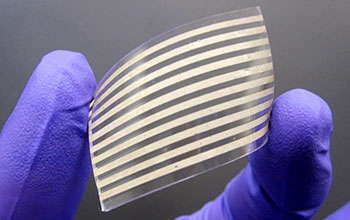Multimedia Gallery
Highly conductive and elastic conductors using silver nanowires
Researchers at North Carolina State University developed highly conductive and elastic conductors made from silver nanoscale wires (nanowires). The silver nanowires can be printed to fabricate patterned stretchable conductors.
More about this image
In 2012, researchers at North Carolina State University (NC State) developed highly conductive and elastic conductors made from silver nanoscale wires (nanowires). These elastic conductors can be used to develop stretchable electronic devices.
Stretchable circuitry can be used as an electronic "skin" to help robots pick up delicate objects without breaking them, and stretchable displays and antennas could make cellphones and other electronic devices stretch and compress without affecting their performance. However, first conductors must be produced that are elastic and able to effectively and reliably transmit electric signals regardless of whether they are deformed. The NC State researchers developed such elastic conductors using silver nanowires.
The new technique developed at NC State embeds highly conductive silver nanowires in a polymer that can withstand significant stretching without adversely affecting the material’s conductivity. This makes it attractive as a component for use in stretchable electronic devices.
This research was supported by the National Science Foundation (grant CMMI 10-30637).
This research was funded by NSF (grant CMMI 10-30637).
To learn more about this research, see the NC State news story Researchers Create Highly Conductive and Elastic Conductors Using Silver Nanowires. (Date image taken: 2011; date originally posted to NSF Multimedia Gallery: Dec. 27, 2017)
Credit: Yong Zhu, North Carolina State University
See other images like this on your iPhone or iPad download NSF Science Zone on the Apple App Store.
Images and other media in the National Science Foundation Multimedia Gallery are available for use in print and electronic material by NSF employees, members of the media, university staff, teachers and the general public. All media in the gallery are intended for personal, educational and nonprofit/non-commercial use only.
Images credited to the National Science Foundation, a federal agency, are in the public domain. The images were created by employees of the United States Government as part of their official duties or prepared by contractors as "works for hire" for NSF. You may freely use NSF-credited images and, at your discretion, credit NSF with a "Courtesy: National Science Foundation" notation.
Additional information about general usage can be found in Conditions.
Also Available:
Download the high-resolution JPG version of the image. (4.2 MB)
Use your mouse to right-click (Mac users may need to Ctrl-click) the link above and choose the option that will save the file or target to your computer.

